Numerical Study of 3D MHD Mixed Convection and Entropy Generation in Trapezoidal Porous Enclosure Filled with a Hybrid Nanofluid: Effect of Zigzag Wall and Spinning Inner Cylinder
Abstract
:1. Introduction
2. Studied Configuration and Mathematical Formulation
2.1. Mathematical Model
The Thermophysical Properties of the Hybrid Nanoliquid
2.2. Boundary Conditions
The Total Entropy Generation
3. Mesh Sensitivity, Computation Procedure and Code Validation
3.1. Mesh Sensitivity
3.2. Computation Procedure
3.3. Code Validation
4. Results and Discussion
4.1. The Effect of Darcy Number and the Addition of Different Concentrations of Nanoparticles on Heat Transfer and Flow Behavior
4.2. The Effect of the Hartman Number on Heat Transfer and Flow Behavior
4.3. The Effect of the Rotation Velocity of the Cylinder on the Heat Transfer and the Flow Behavior
4.4. The Effect of the Zigzag Pattern of the Hot Wall on the Heat Transfer and the Flow Behavior
4.5. The Effect of Nanoparticle Amount and Darcy and Hartman Numbers on the Evolution of the Average Nusselt Number
4.6. The Effect of Cylinder Rotation Speed and Darcy and Hartman Numbers on the Evolution of the Average Nusselt Number
4.7. The Effect of Cylinder Rotation Speed, Hartman Number, and Hot Wall Zigzag Pattern on the Evolution of the Average Nusselt Number
4.8. The Effect of Darcy Number and Adding Different Concentrations of Nanoparticles on Bejan Number Development
4.9. The Effect of Darcy and Hartman Numbers on Bejan Number Development
4.10. The Effect of the Hartman Number and Cylinder Angular Velocity on Bejan Number Development
4.11. The Effect of Hot Wall Number of Undulations and Cylinder Angular Velocity on Bejan Number Development
4.12. The Effect of the Nanoparticle Concentration and Darcy and Hartman Numbers on the Development of the Average Bejan Number
4.13. The Effect of the Tube Rotation Speed and Darcy and Hartman Numbers on the Development of the Average Bejan Number
4.14. The Effect of the Tube Rotation Speed, the Hot Wall Zigzag Pattern, and the Hartman Number on the Development of the Average Bejan Number
5. Conclusions
- The fluidity of the fluid is stronger with increasing Darcy number and rotating velocity of the inner tube.
- High values of Hartman number result in a significant stagnation of flow motion.
- Increasing the concentration of nanoparticles leads to an increase in the thermal conductivity of the fluid; hence, the heat spread reaches high values.
- The maximum values of average Nusselt number were reached with high numbers of zigzag undulations in the hot wall with the lowest values of Hartman number.
- The Darcy number and the rotating speed of the inner tube positively affect Nu and heat transfer rate at high values.
- The average Nusselt number increases with greater domination of forced convection, while forced convection increases with increasing inner tube spinning rate and Darcy number when there is no magnetic field.
- The entropy generation due to fluid friction is related to fluid fluidity. It increases with both increasing Darcy number and increasing angular velocity of the inner cylinder or with both decreasing Hartman number and decreasing nanoparticle amount.
- The Bejan number decreases with both increasing Darcy number and increasing angular velocity of the inner cylinder or with decreasing Hartman number and nanoparticle amount.
- High numbers of undulations in the hot wall play an important role in reducing the irreversibility phenomenon by increasing the fluid movement inside the cavity (i.e., increasing the friction in the fluid).
Author Contributions
Funding
Informed Consent Statement
Data Availability Statement
Acknowledgments
Conflicts of Interest
Nomenclatures
| Symbols | |
| B | Magnetic field |
| Be | Bejan number |
| cp | Specific heat (J·kg−1·K−1) |
| Da | Darcy number |
| g | Gravitational acceleration, (m·s−2) |
| Ha | Hartman number |
| k | Thermal conductivity, (W·m−1·K−1) |
| L | Cavity width, (m) |
| Nu | Nusselt number |
| p | Pressure, (Pa) |
| P | Dimensionless pressure |
| Pr | Prandtl number |
| R | The dimensionless radius of the cylinder |
| r | The radius of the cylinder |
| Ra | Rayleigh number |
| Re | Reynolds number |
| Ri | Richardson number |
| S | Entropy generation |
| T | Temperature, (K) |
| u, v, w | Velocities in x, y, z-directions, (m·s−1) |
| U, V, W | Dimensionless velocities component in X, Y, Z-directions |
| X, Y, Z | Dimensionless coordinates in x, y, and z directions |
| Greek letters | |
| Thermal diffusivity (m2·s−1) | |
| Thermal expansion coefficient (K−1) | |
| Porosity | |
| Dimensionless temperature | |
| Permeability (m2) | |
| Dynamic viscosity (Pa.s) | |
| Kinematic viscosity (m2·s−1) | |
| Density (kg/m3) | |
| Electrical conductivity (Ω−1·m−1) | |
| Nanoparticle concentration | |
| Dimensionless angular rotational velocity | |
| Angular rotational velocity (rad·s−1) | |
| Subscript | |
| eff | Effective |
| f | fluid |
| ff | Fluid friction |
| hnf | Hybrid nanofluid |
| mf | Magnetic field |
| nf | Nanofluid |
| np | Nanoparticle |
| s | Solid matrix |
| th | Thermal |
| tot | Total |
References
- Hussein, A.K.; Walunj, A.; Kolsi, L. Applications of nanotechnology to enhance the performance of the direct absorption solar collectors. J. Therm. Eng. 2016, 2, 529–540. [Google Scholar] [CrossRef]
- Bendrer, B.; Abderrahmane, A.; Ahmed, S.E.; Raizah, Z.A. 3D magnetic buoyancy-driven flow of hybrid nanofluids confined wavy cubic enclosures including multi-layers and heated obstacle. Int. Commun. Heat Mass Transf. 2021, 126, 105431. [Google Scholar] [CrossRef]
- Ghadikolaei, S.; Gholinia, M. 3D mixed convection MHD flow of GO-MoS2 hybrid nanoparticles in H2O–(CH2OH)2 hybrid base fluid under the effect of H2 bond. Int. Commun. Heat Mass Transf. 2020, 110, 104371. [Google Scholar] [CrossRef]
- Al-Kouz, W.; Bendrer, B.A.-I.; Aissa, A.; Almuhtady, A.; Jamshed, W.; Nisar, K.S.; Mourad, A.; Alshehri, N.A.; Zakarya, M. Galerkin finite element analysis of magneto two-phase nanofluid flowing in double wavy enclosure comprehending an adiabatic rotating cylinder. Sci. Rep. 2021, 11, 16494. [Google Scholar] [CrossRef] [PubMed]
- Garmroodi, M.D.; Ahmadpour, A.; Talati, F. MHD mixed convection of nanofluids in the presence of multiple rotating cylinders in different configurations: A two-phase numerical study. Int. J. Mech. Sci. 2019, 150, 247–264. [Google Scholar] [CrossRef]
- Koulali, A.; Abderrahmane, A.; Jamshed, W.; Hussain, S.M.; Nisar, K.S.; Abdel-Aty, A.-H.; Yahia, I.S.; Eid, M.R. Comparative Study on Effects of Thermal Gradient Direction on Heat Exchange between a Pure Fluid and a Nanofluid: Employing Finite Volume Method. Coatings 2021, 11, 1481. [Google Scholar] [CrossRef]
- Selimefendigil, F.; Öztop, H.F. Modeling and optimization of MHD mixed convection in a lid-driven trapezoidal cavity filled with alumina–water nanofluid: Effects of electrical conductivity models. Int. J. Mech. Sci. 2018, 136, 264–278. [Google Scholar] [CrossRef]
- Chamkha, A.J.; Selimefendigil, F.; Ismael, M.A. Mixed convection in a partially layered porous cavity with an inner rotating cylinder. Numer. Heat Transfer Part A Appl. 2016, 69, 659–675. [Google Scholar] [CrossRef]
- Roslan, R.; Saleh, H.; Hashim, I. Effect of rotating cylinder on heat transfer in a square enclosure filled with nanofluids. Int. J. Heat Mass Transf. 2012, 55, 7247–7256. [Google Scholar] [CrossRef]
- Al-Farhany, K.; Abdulsahib, A.D. Study of mixed convection in two layers of saturated porous medium and nanofluid with rotating circular cylinder. Prog. Nucl. Energy 2021, 135, 103723. [Google Scholar] [CrossRef]
- Ghasemi, K.; Siavashi, M. MHD nanofluid free convection and entropy generation in porous enclosures with different conductivity ratios. J. Magn. Magn. Mater. 2017, 442, 474–490. [Google Scholar] [CrossRef]
- Hussein, A.K.; Hamzah, H.K.; Ali, F.H.; Kolsi, L. Mixed convection in a trapezoidal enclosure filled with two layers of nanofluid and porous media with a rotating circular cylinder and a sinusoidal bottom wall. J. Therm. Anal. 2020, 141, 2061–2079. [Google Scholar] [CrossRef]
- Pal, S.; Bhattacharyya, S.; Pop, I. Effect of solid-to-fluid conductivity ratio on mixed convection and entropy generation of a nanofluid in a lid-driven enclosure with a thick wavy wall. Int. J. Heat Mass Transf. 2018, 127, 885–900. [Google Scholar] [CrossRef]
- Cho, C.-C. Heat transfer and entropy generation of mixed convection flow in Cu-water nanofluid-filled lid-driven cavity with wavy surface. Int. J. Heat Mass Transf. 2018, 119, 163–174. [Google Scholar] [CrossRef]
- Mekroussi, S.; Nehari, D.; Bouzit, M.; Chemloul, N.-E.S. Analysis of mixed convection in an inclined lid-driven cavity with a wavy wall. J. Mech. Sci. Technol. 2013, 27, 2181–2190. [Google Scholar] [CrossRef]
- Jarray, A.; Mehrez, Z.; El Cafsi, A. Mixed convection Ag-MgO/water hybrid nanofluid flow in a porous horizontal channel. Eur. Phys. J. Spec. Top. 2019, 228, 2677–2693. [Google Scholar] [CrossRef]
- Aich, W. CFD analysis of three-dimensional natural convection and entropy generation in triangular cavity with inserted isothermal heater. Univ. Ha’il-J. Sci. 2018, 1, 29–40. [Google Scholar]
- Kolsi, L. MHD mixed convection and entropy generation in a 3D lid-driven cavity. Front. Heat Mass Transf. 2016, 7, 26. [Google Scholar] [CrossRef] [Green Version]
- Hamzah, H.K.; Ali, F.H.; Hatami, M. MHD mixed convection and entropy generation of CNT-water nanofluid in a wavy lid-driven porous enclosure at different boundary conditions. Sci. Rep. 2022, 12, 2881. [Google Scholar] [CrossRef]
- Nguyen, Q.; Bahrami, D.; Kalbasi, R.; Karimipour, A. Functionalized multi—walled carbon nano tubes nanoparticles dispersed in water through an magneto hydro dynamic nonsmooth duct equipped with sinusoidal—wavy wall: Diminishing vortex intensity via nonlinear Navier–Stokes equations. Math. Methods Appl. Sci. 2020. [Google Scholar] [CrossRef]
- Barnoon, P.; Toghraie, D.; Dehkordi, R.B.; Abed, H. MHD mixed convection and entropy generation in a lid-driven cavity with rotating cylinders filled by a nanofluid using two phase mixture model. J. Magn. Magn. Mater. 2019, 483, 224–248. [Google Scholar] [CrossRef]
- Elshehabey, H.M.; Raizah, Z.; Öztop, H.F.; Ahmed, S.E. MHD natural convective flow of Fe3O4−H2O ferrofluids in an inclined partial open complex-wavy-walls ringed enclosures using non-linear Boussinesq approximation. Int. J. Mech. Sci. 2019, 170, 105352. [Google Scholar] [CrossRef]
- Chamkha, A.J.; Ahmed, S.E. Unsteady MHD heat and mass transfer by mixed convection flow in the forward stagnation region of a rotating sphere at different wall conditions. Chem. Eng. Commun. 2012, 199, 122–141. [Google Scholar] [CrossRef]
- Ahmed, S.E. FEM-CBS algorithm for convective transport of nanofluids in inclined enclosures filled with anisotropic non-Darcy porous media using LTNEM. Int. J. Numer. Methods Heat Fluid Flow 2021, 31, 570–594. [Google Scholar] [CrossRef]
- Ahmed, S.E.; Hussein, A.K.; Mansour, M.A.; Raizah, Z.A.; Zhang, X. MHD mixed convection in trapezoidal enclosures filled with micropolar nanofluids. Nanosci. Technol. Int. J. 2018, 9, 343–372. [Google Scholar] [CrossRef]
- Mansour, M.A.; Ahmed, S.E. Mixed convection flows in a square lid-driven cavity with heat source at the bottom utilising nanofluid. Can. J. Chem. Eng. 2012, 90, 100–110. [Google Scholar] [CrossRef]
- Cherif, B.M.; Abderrahmane, A.; Saeed, A.M.; Qasem, N.A.A.; Younis, O.; Marzouki, R.; Chung, J.D.; Shah, N.A. Hydrothermal and Entropy Investigation of Nanofluid Mixed Convection in Triangular Cavity with Wavy Boundary Heated from below and Rotating Cylinders. Nanomaterials 2022, 12, 1469. [Google Scholar] [CrossRef]
- Radouane, F.; Abderrahmane, A.; Mebarek-Oudina, F.; Ahmed, W.; Rashad, A.M.; Sahnoun, M.; Ali, H.M. Magneto-free convective of hybrid nanofluid inside non-Darcy porous enclosure containing an adiabatic rotating cylinder. Energy Sources Part A Recovery Util. Environ. Eff. 2020, 42, 1–16. [Google Scholar]
- Abderrahmane, A.; Qasem, N.A.A.; Younis, O.; Marzouki, R.; Mourad, A.; Shah, N.A.; Chung, J.D. MHD Hybrid Nanofluid Mixed Convection Heat Transfer and Entropy Generation in a 3-D Triangular Porous Cavity with Zigzag Wall and Rotating Cylinder. Mathematics 2022, 10, 769. [Google Scholar] [CrossRef]

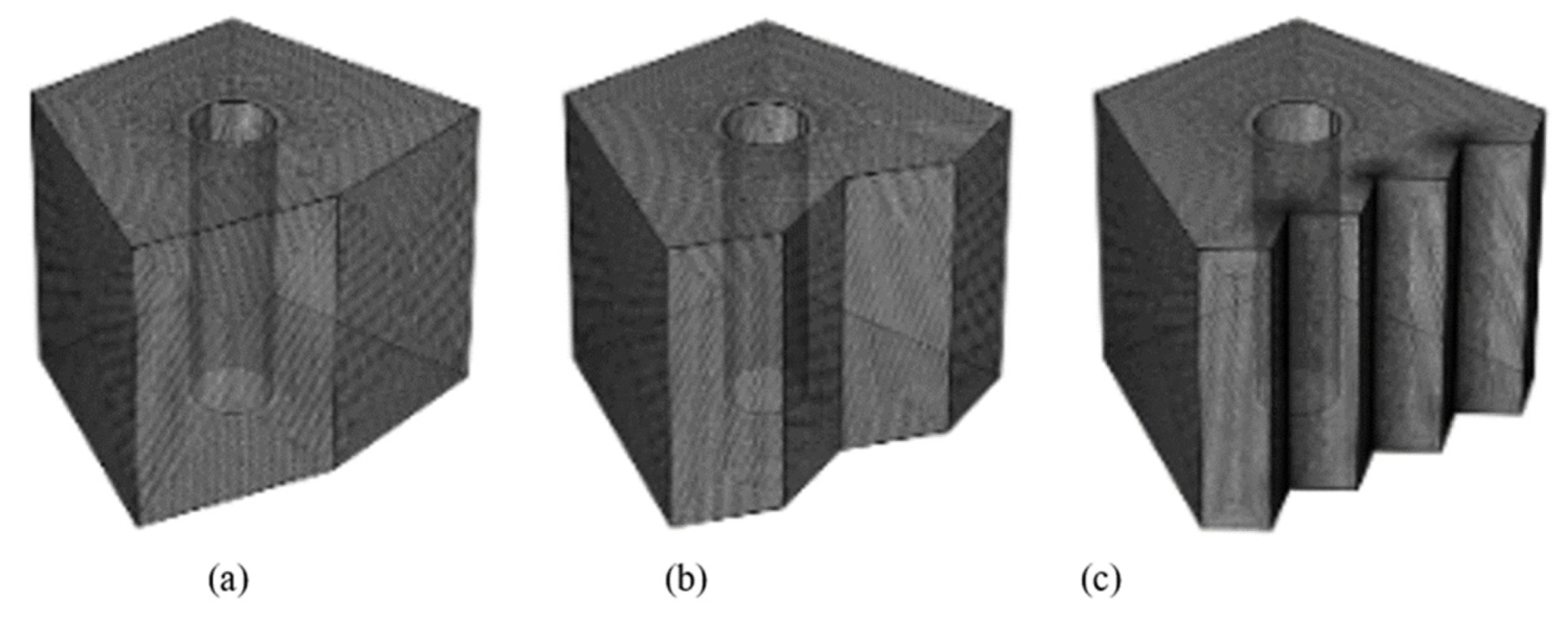
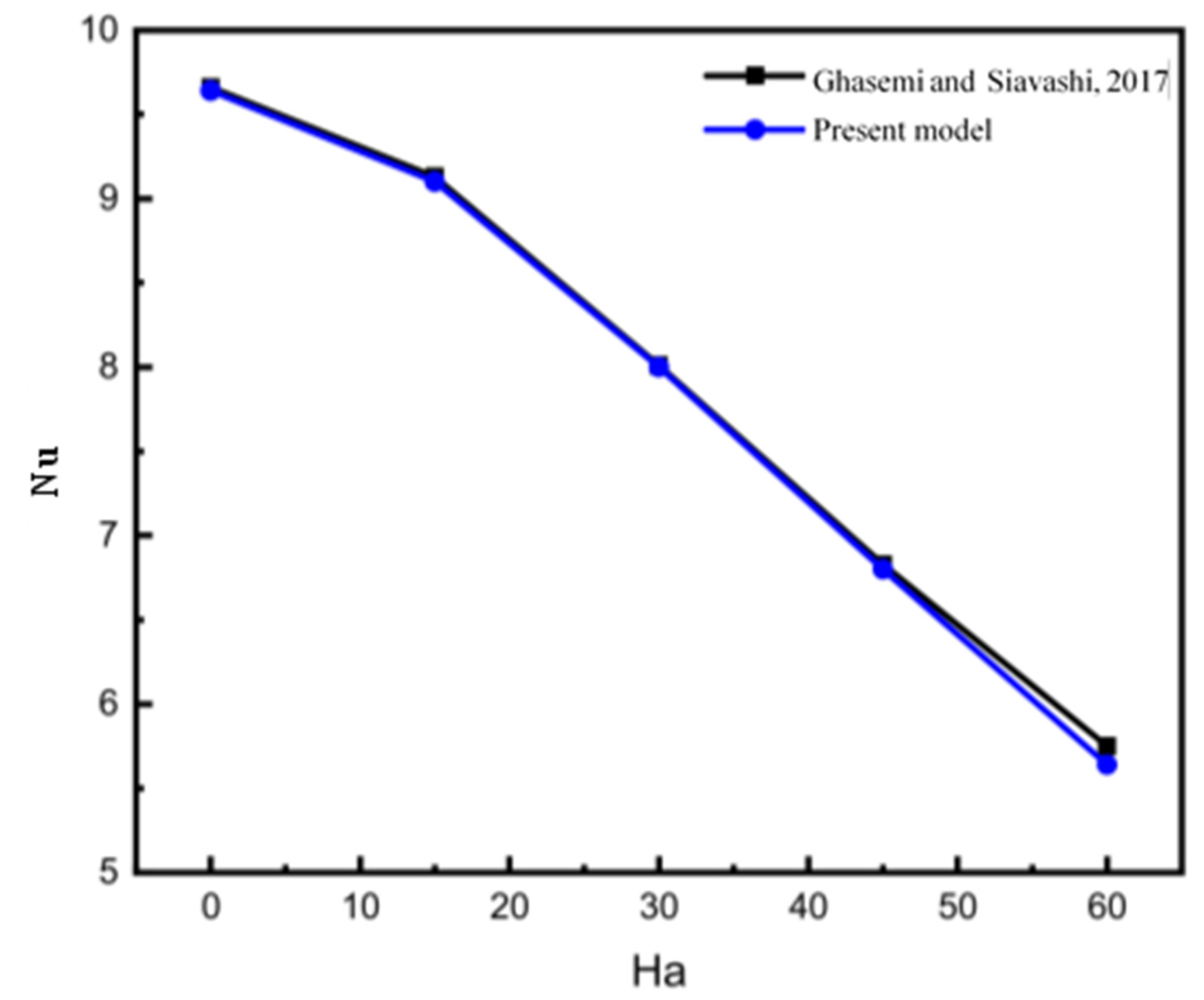
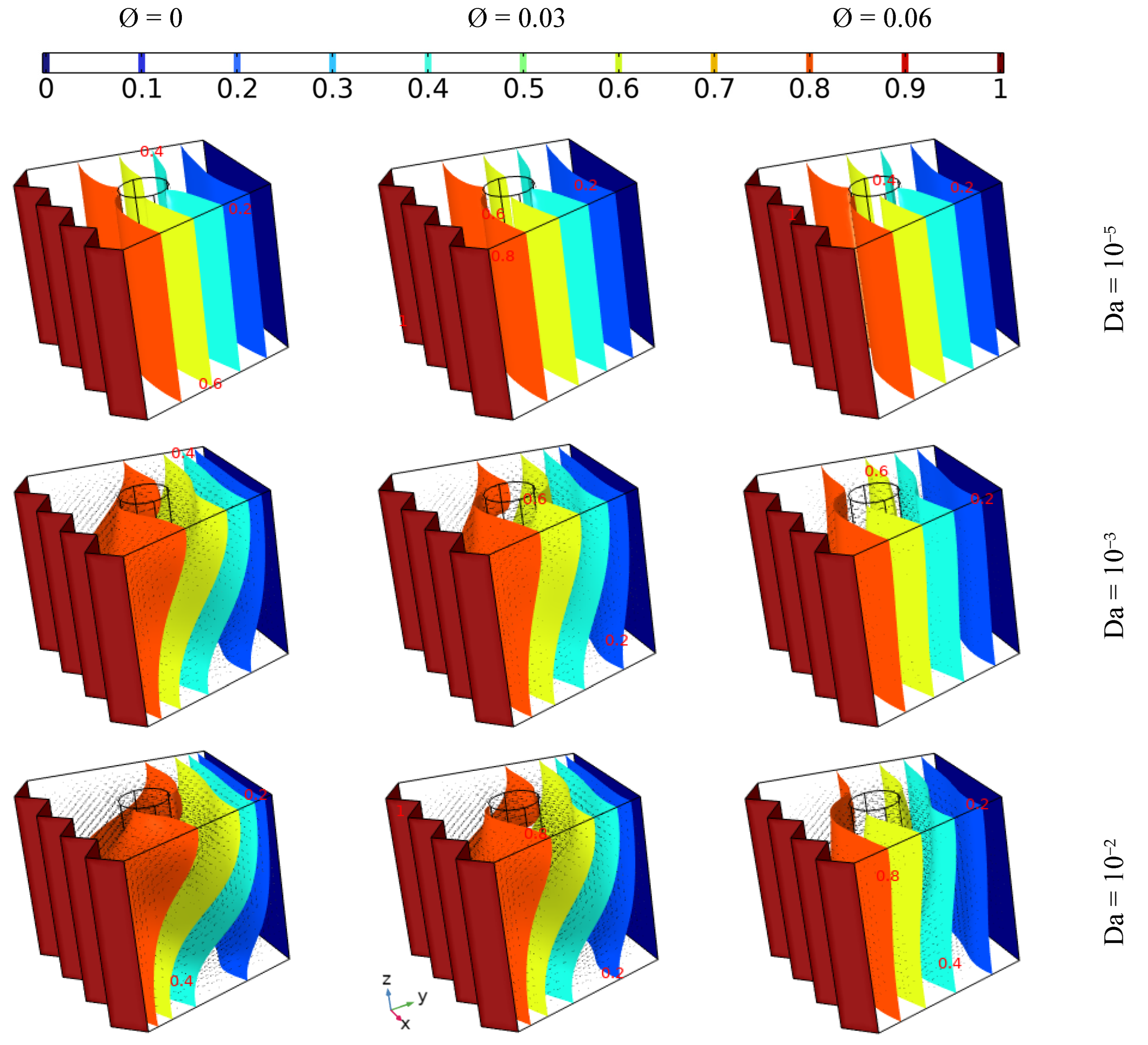
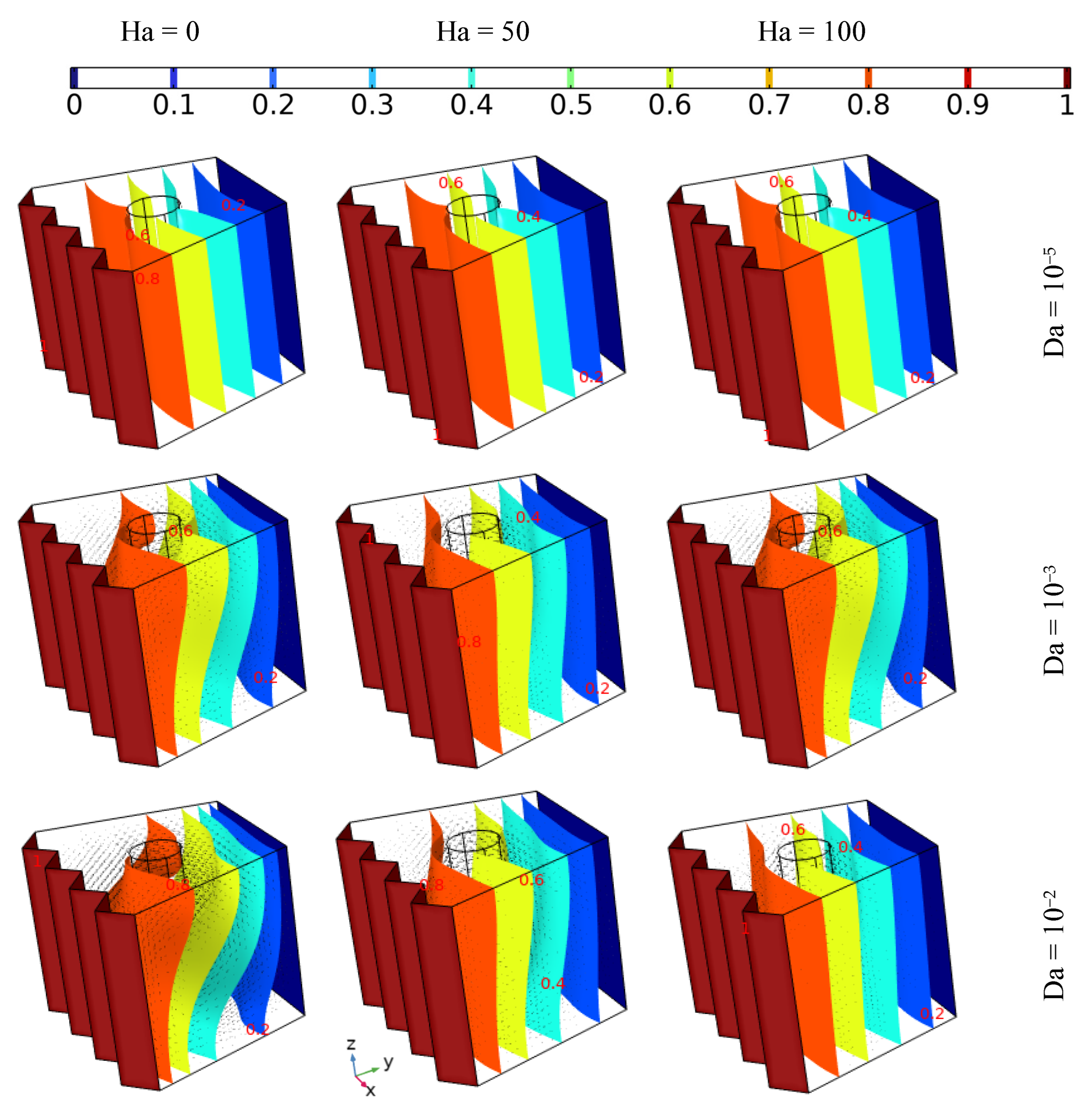
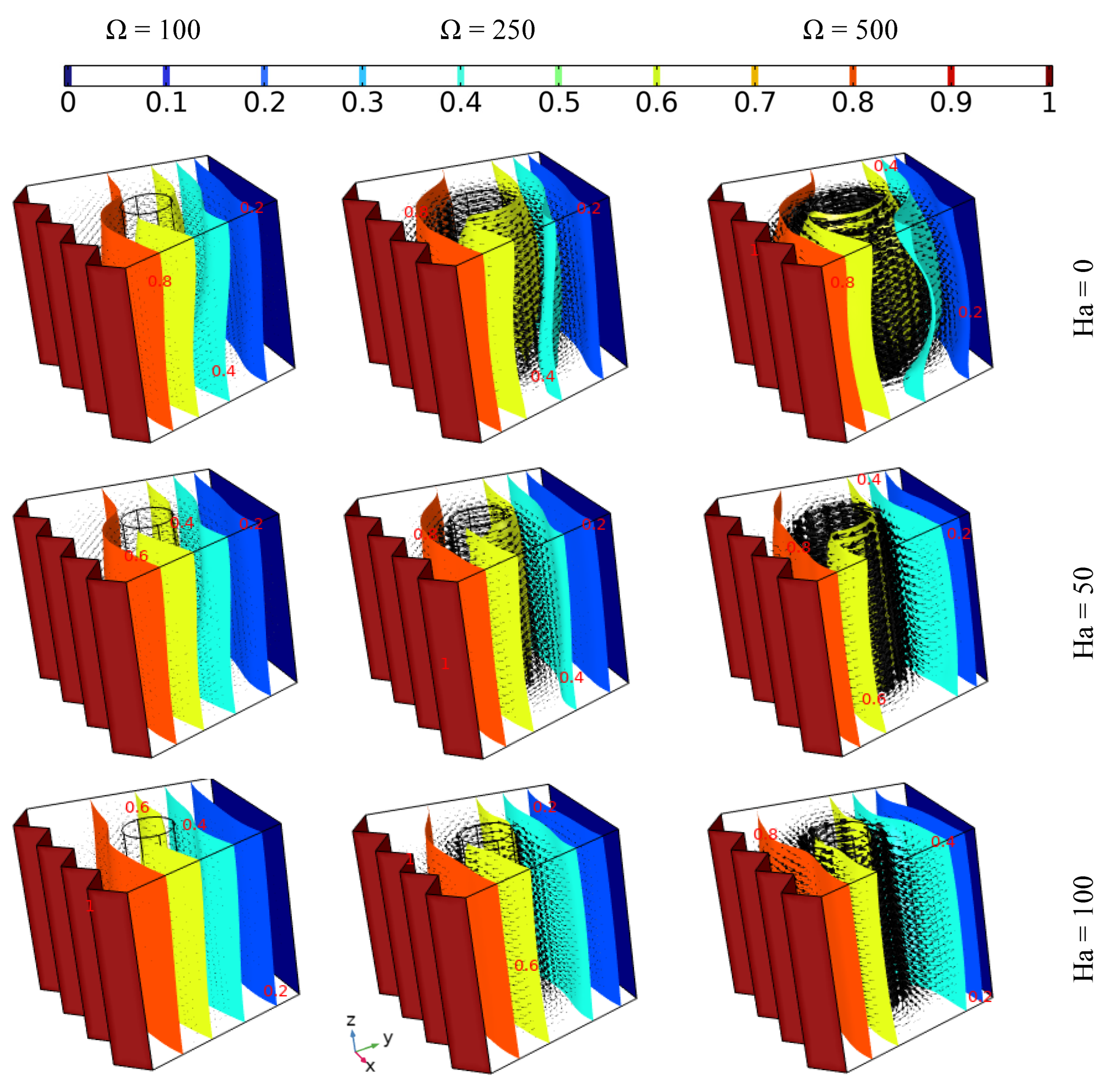
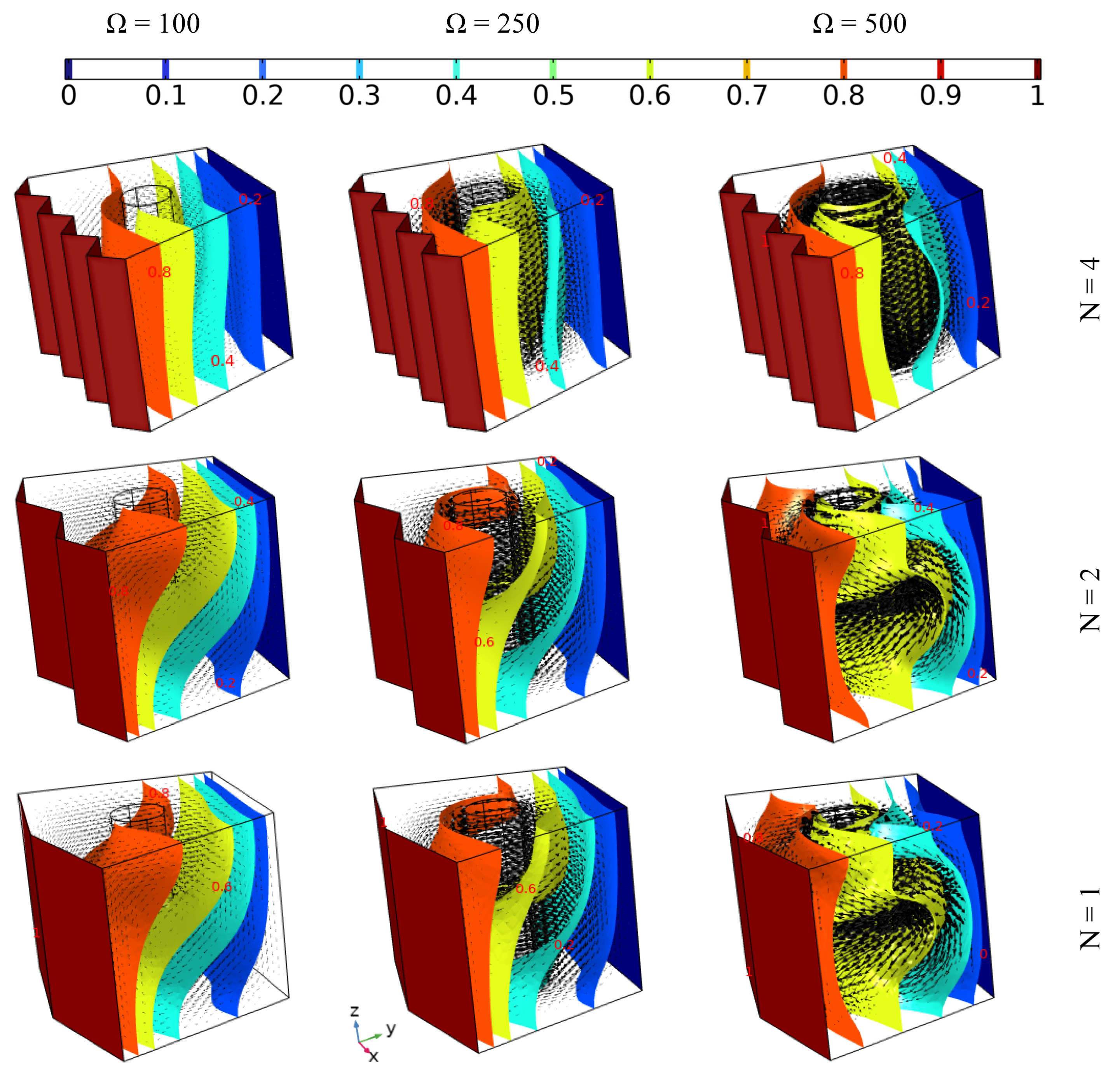

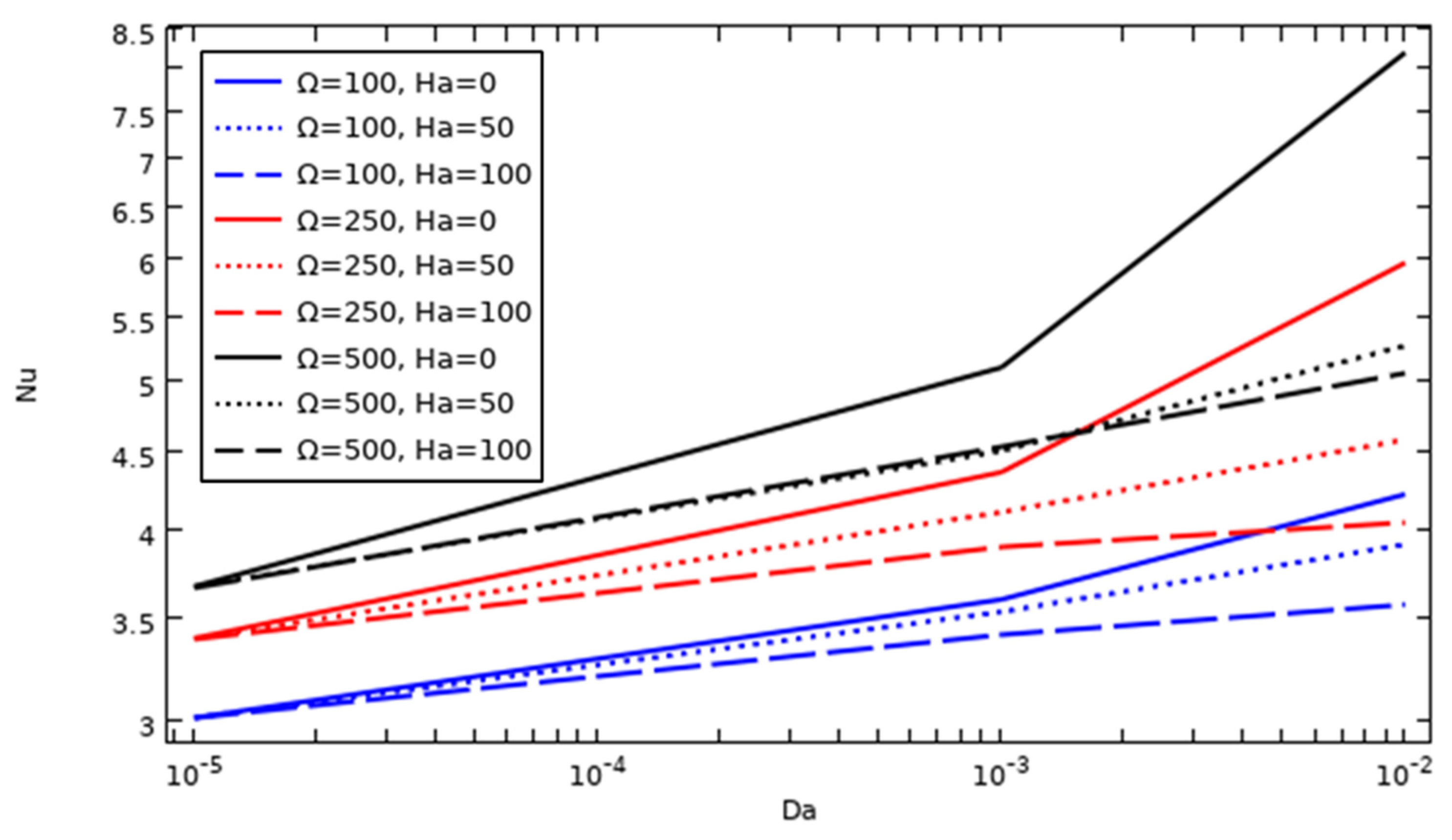


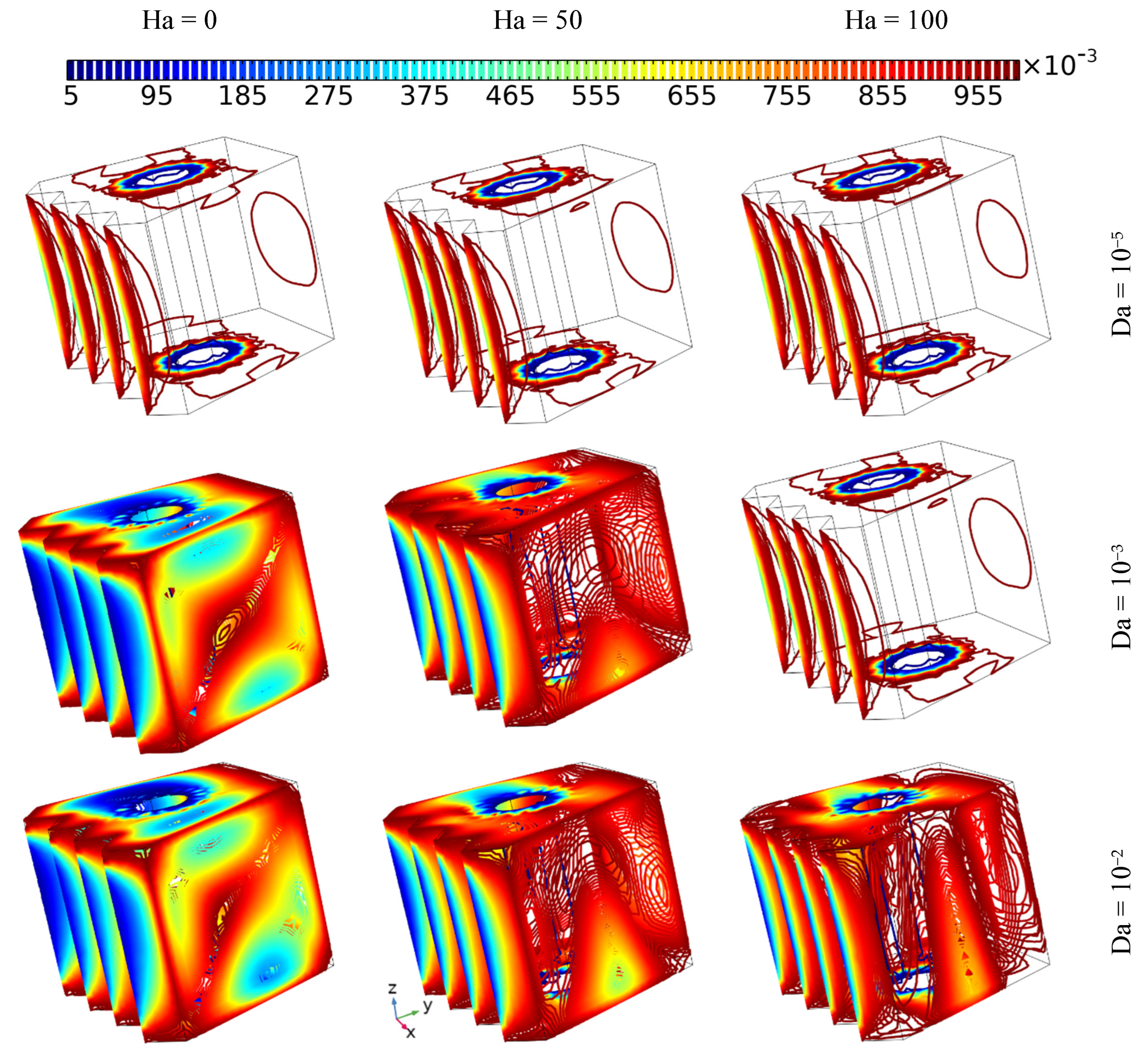
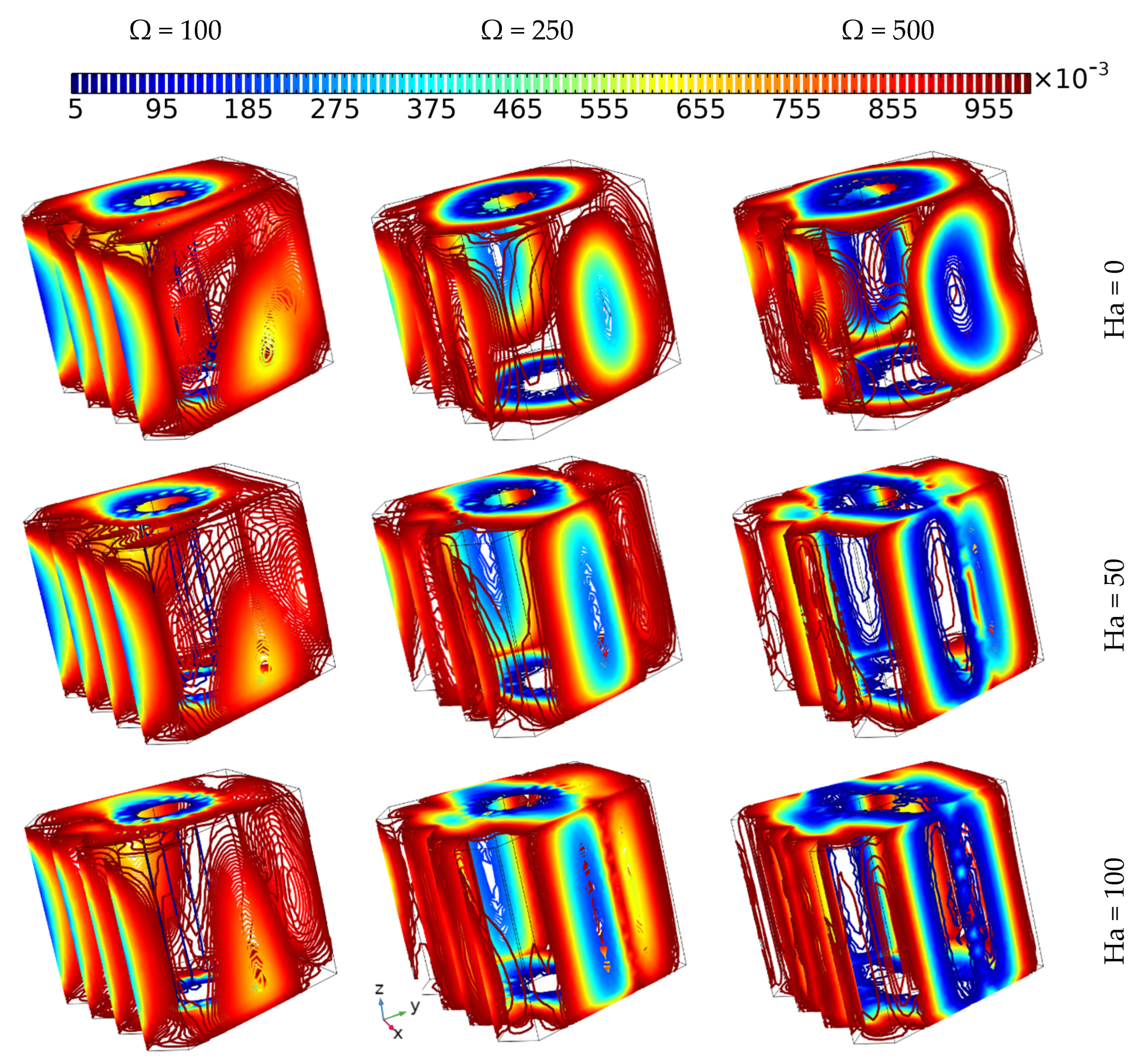
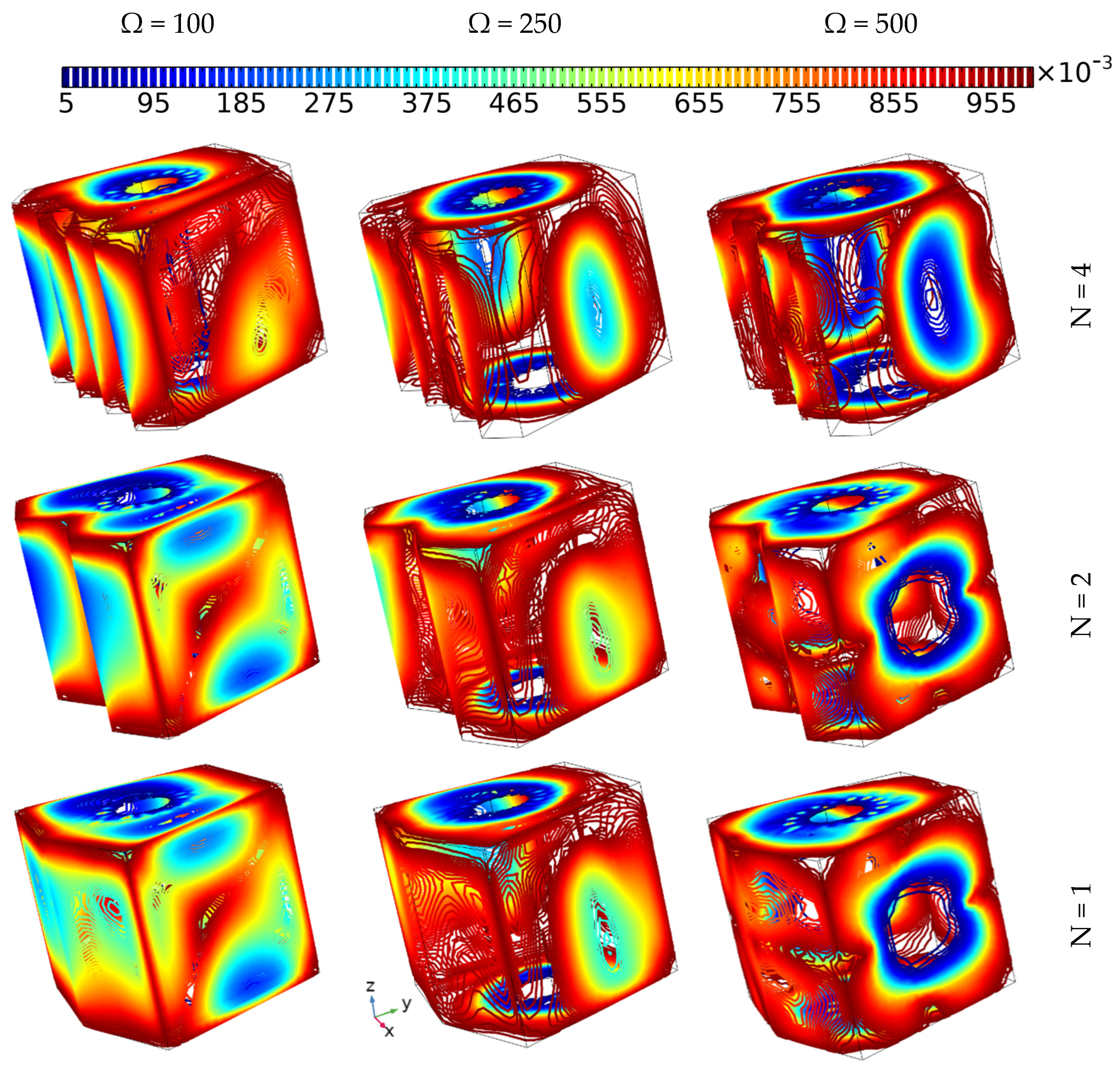
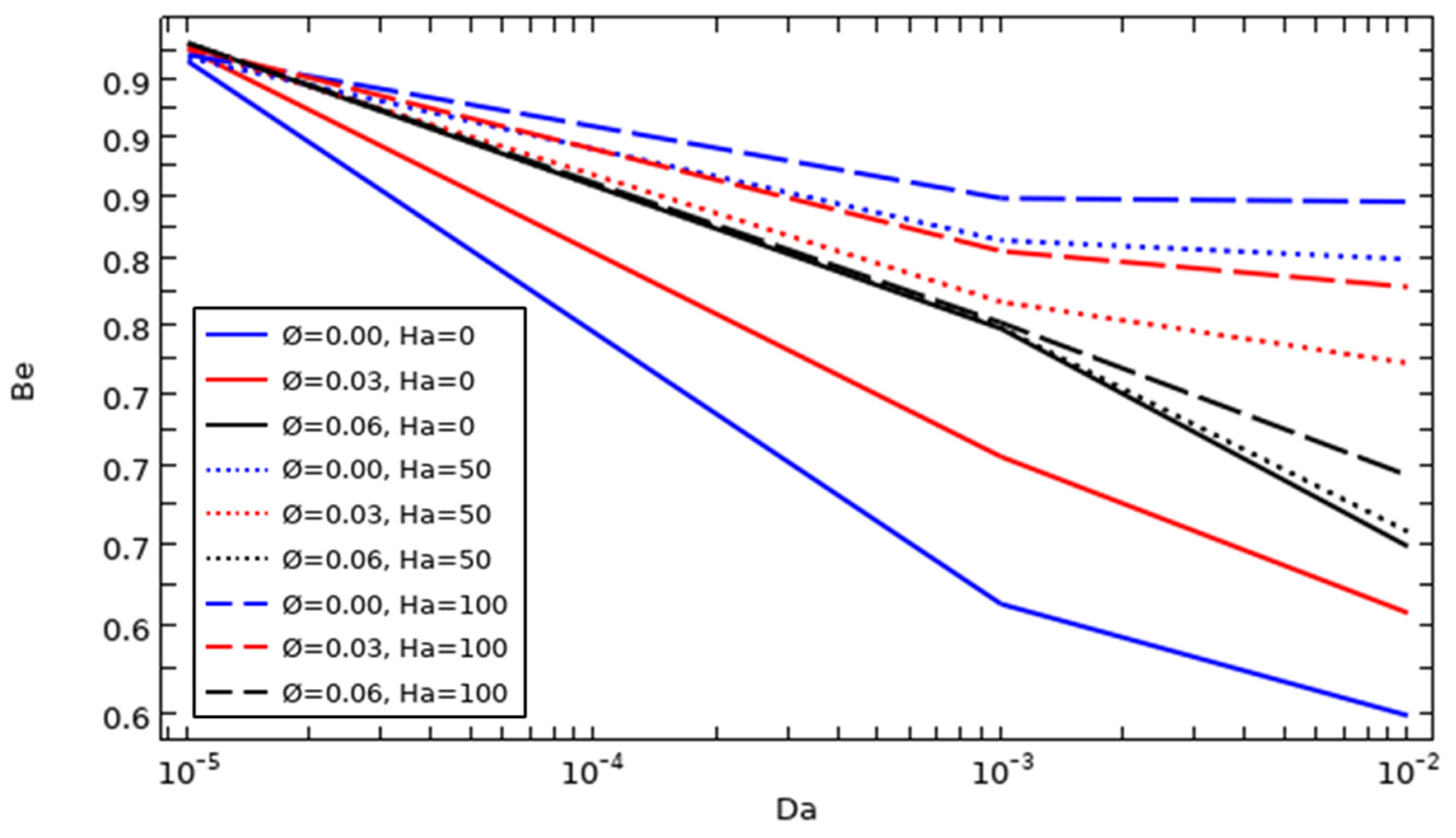
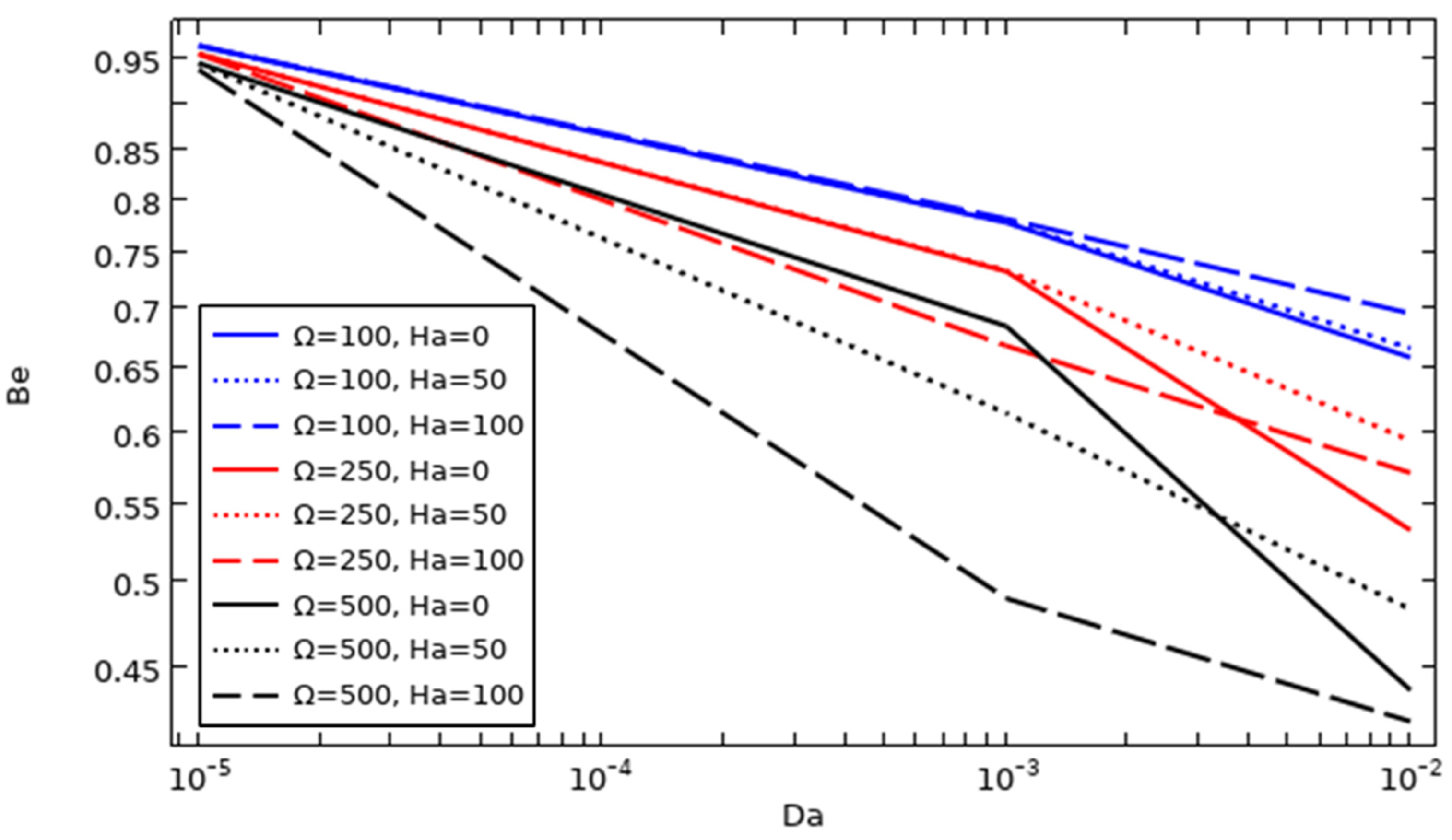

| Property | Water | MoS2 | GO |
|---|---|---|---|
| (kg·m−3) | 997.1 | 5060 | 1800 |
| Heat capacity, Cp (J·kg−1·K−1) | 4179 | 397.21 | 717 |
| (W·m−1·K−1) | 0.613 | 904.4 | 5000 |
| (K−1) | 5.8 × 10−4 | 2.8424 × 10−5 | 2.84 × 10−4 |
| (Ω−1·m−1) | 9.75 × 10−4 | 2.09 × 104 | 6.30 × 107 |
| Dynamic viscosity, μ (Pa.s) | 0.001003 | - | - |
| Property | Classical Nanofluid | Hybrid Nanofluid |
|---|---|---|
| Density | ||
| Heat capacity | ||
| Coefficient of thermal expansion | ||
| Electrical conductivity | ||
| Thermal conductivity | ||
| Viscosity | ||
| Thermal Condition | Velocity Condition | |
|---|---|---|
| The inclined Lift wall | Adiabatic | (no-slip) |
| The inclined right wall | adiabatic | (no-slip) |
| The top wall | adiabatic | (no-slip) |
| The Bottom wall | adiabatic | (no-slip) |
| The zigzag wall | (no-slip) | |
| The front wall of the zigzag one | (no-slip) | |
| The central tube wall | adiabatic |
| Total Number of Elements | Average Nusselt Number | |
|---|---|---|
| N = 4 | 137,688 | 2.0245 |
| N = 2 | 69,639 | 1.7521 |
| N = 1 | 69,180 | 2.0041 |
| N = 4 | 348,525 | 2.2758 |
| N = 2 | 182,971 | 1.8745 |
| N = 1 | 181,506 | 2.0940 |
| N = 4 | 994,968 | 2.3167 |
| N = 2 | 590,354 | 1.9595 |
| N = 1 | 586,133 | 2.1472 |
| N = 4 | 3,958,438 | 2.3174 |
| N = 2 | 2,542,173 | 1.9599 |
| N = 1 | 2,519,898 | 2.1502 |
Publisher’s Note: MDPI stays neutral with regard to jurisdictional claims in published maps and institutional affiliations. |
© 2022 by the authors. Licensee MDPI, Basel, Switzerland. This article is an open access article distributed under the terms and conditions of the Creative Commons Attribution (CC BY) license (https://creativecommons.org/licenses/by/4.0/).
Share and Cite
Maneengam, A.; Bouzennada, T.; Abderrahmane, A.; Ghachem, K.; Kolsi, L.; Younis, O.; Guedri, K.; Weera, W. Numerical Study of 3D MHD Mixed Convection and Entropy Generation in Trapezoidal Porous Enclosure Filled with a Hybrid Nanofluid: Effect of Zigzag Wall and Spinning Inner Cylinder. Nanomaterials 2022, 12, 1974. https://doi.org/10.3390/nano12121974
Maneengam A, Bouzennada T, Abderrahmane A, Ghachem K, Kolsi L, Younis O, Guedri K, Weera W. Numerical Study of 3D MHD Mixed Convection and Entropy Generation in Trapezoidal Porous Enclosure Filled with a Hybrid Nanofluid: Effect of Zigzag Wall and Spinning Inner Cylinder. Nanomaterials. 2022; 12(12):1974. https://doi.org/10.3390/nano12121974
Chicago/Turabian StyleManeengam, Apichit, Tarek Bouzennada, Aissa Abderrahmane, Kaouther Ghachem, Lioua Kolsi, Obai Younis, Kamel Guedri, and Wajaree Weera. 2022. "Numerical Study of 3D MHD Mixed Convection and Entropy Generation in Trapezoidal Porous Enclosure Filled with a Hybrid Nanofluid: Effect of Zigzag Wall and Spinning Inner Cylinder" Nanomaterials 12, no. 12: 1974. https://doi.org/10.3390/nano12121974
APA StyleManeengam, A., Bouzennada, T., Abderrahmane, A., Ghachem, K., Kolsi, L., Younis, O., Guedri, K., & Weera, W. (2022). Numerical Study of 3D MHD Mixed Convection and Entropy Generation in Trapezoidal Porous Enclosure Filled with a Hybrid Nanofluid: Effect of Zigzag Wall and Spinning Inner Cylinder. Nanomaterials, 12(12), 1974. https://doi.org/10.3390/nano12121974









